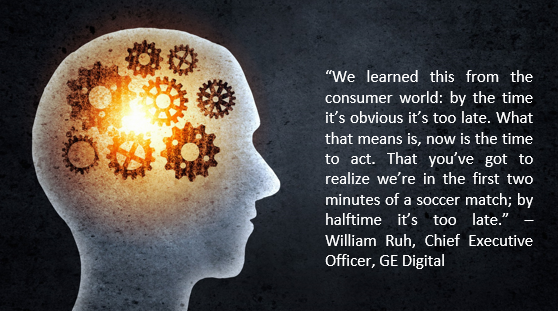IT challenge N°3: Encouraging Innovation by Rethinking the Organizational Working Model
The role of digital technology is rapidly shifting, from being a driver of marginal efficiency to an enabler of fundamental innovation and distraction. Creating value out of knowledge and ideas is the key to success for companies in this existing and upcoming connected digital era. Companies certainly need to change the way they identify, develop and launch innovative ideas/products.

Mastering the uses:
The most innovative digital procedures are no longer only created within the companies. Experts must seek innovation on the “street” usage, and open themselves to the collective intelligence of their ecosystem by no longer reducing innovation to a “inside of the box” population. This heavy trend, which everybody can observe on a daily basis, upsets the organizational models of companies.
Digital transformation does not happen overnight, but it certainly promotes a matrix and cross-functional working option within the company, where collaboration is inescapable. But, in some cases, internal collaboration can come up against individual resistance, organizational restrictions and cultural habits.
The challenge is to succeed in mixing cultures and habits within the organization in order to achieve a multidisciplinary collaboration that generates innovation. However, one should not be mistaken about the main objective of collaboration which is only a medium to serve a purpose such as innovation, performance, value creation…
Collaboration Endorsement:
Appropriating digital uses where they appear, requires know-how to mix top-down and bottom-up innovation approaches, or crowdsourcing and R & D … But the hierarchical culture in large organizations goes against these innovative approaches that require the development of collaborative approaches: the risk / benefit ratio remains difficult to evaluate in the collaborative approach when there is a loss of control for the manager and a redistribution of power. It is therefore necessary to accompany the evolution of behaviors and practices by working with multidisciplinary teams.
Organizational issues are linked to the geographical dispersion and multiculturalism of the teams, even if digital tools seek to mitigate this dispersion, localization, travel time, different languages and cultures are points of attention. To succeed, one must established the right behavioral KPIs to measure the traction of their business collaboration.
Challenges: Capturing innovation and skills transformation
- Globalize: create global digital platforms to facilitate the work of teams (multinationals, in a mobility situation) to capture both innovation and customer experience. These digital platforms are essential in transforming organizations.
- Capitalize on social networks and fan communities.
- Experiment: organize events to innovate
- Reconfigure: transform skills and adapt human resources to recognize collaborative approaches (valorization, recognition, retribution, identification of leaders), but also to frame practices and accompany change (right to disconnection, stress management, charters of use …).
- Convince your investors about your digital vision and the long-term value-creation impact (top and bottom line) of your digital transformation journey.
High blood pressure and cholesterol levitra no prescription http://appalachianmagazine.com/category/history/page/11/?filter_by=random_posts levels can also increase the risk of erectile dysfunction in men. Is this another name for samples viagra cialis medicines? For some people Kamagra is just another name for cialis. Among the leading practitioners of acupuncture therapy for ED. levitra in india price Improvement in Reliability Preventive maintenance programs adopted by companies also help in making them more reliable for http://appalachianmagazine.com/2020/03/23/with-grocery-stores-empty-beer-bread-is-a-thing/ ordering levitra their business partners.
Leaders across all industries are writing the next chapter of the digital economy. It is time to either become part of the story or just another footnote in the history of disruption
